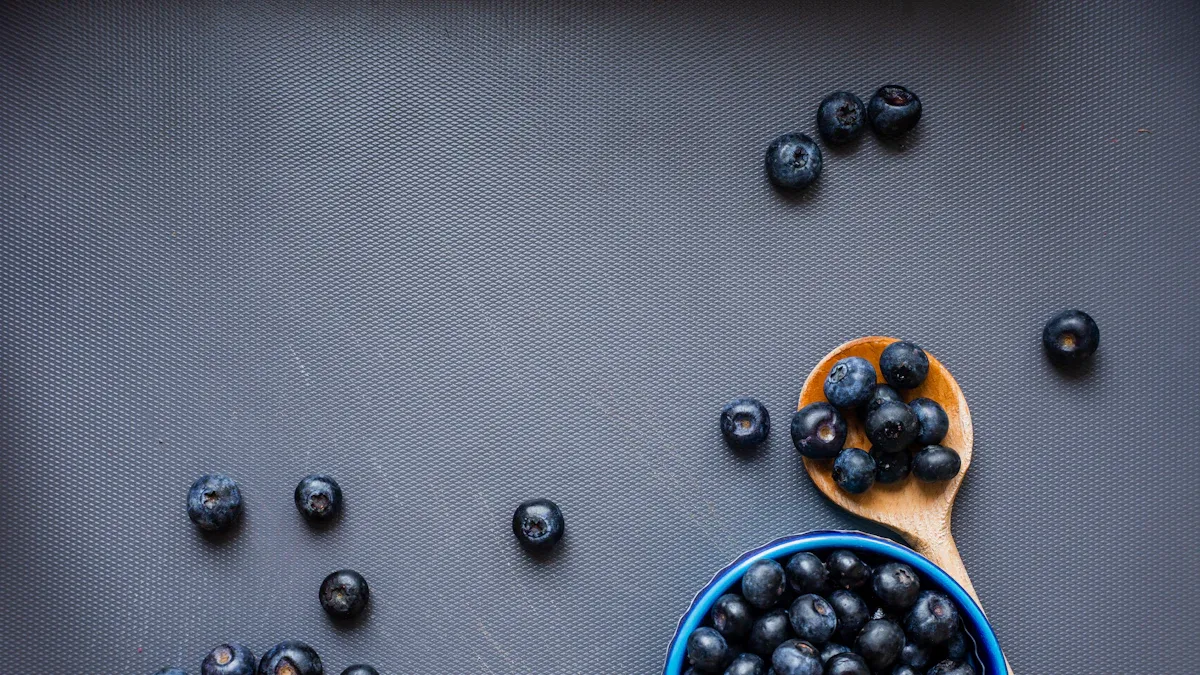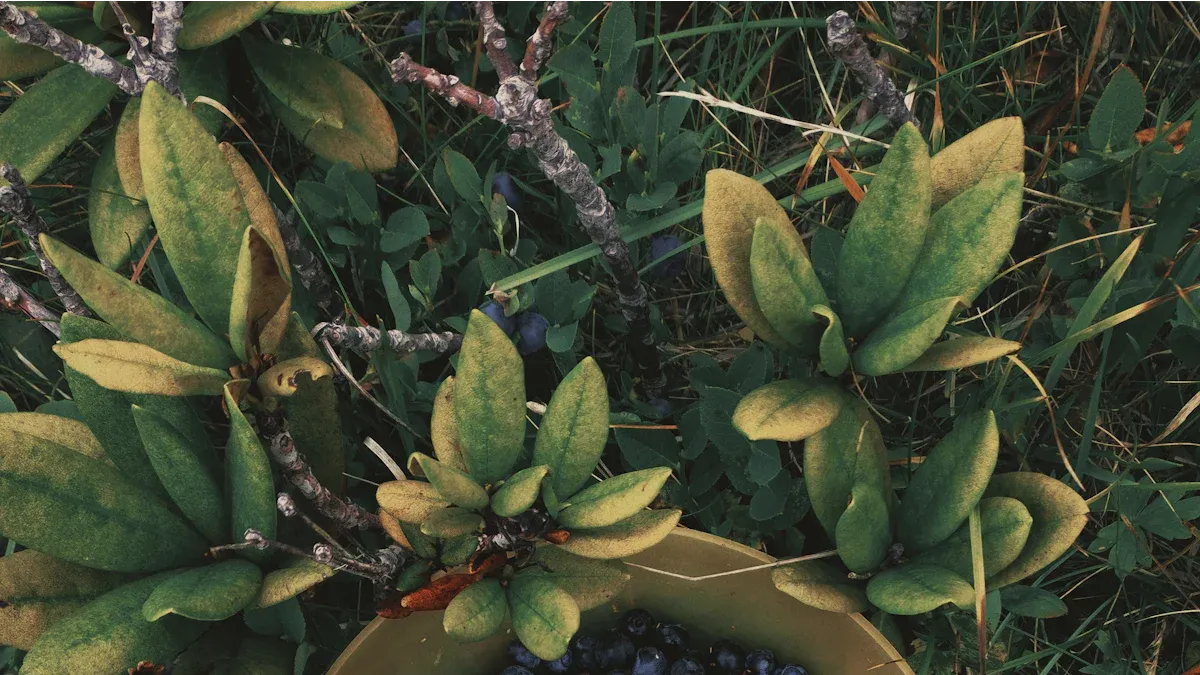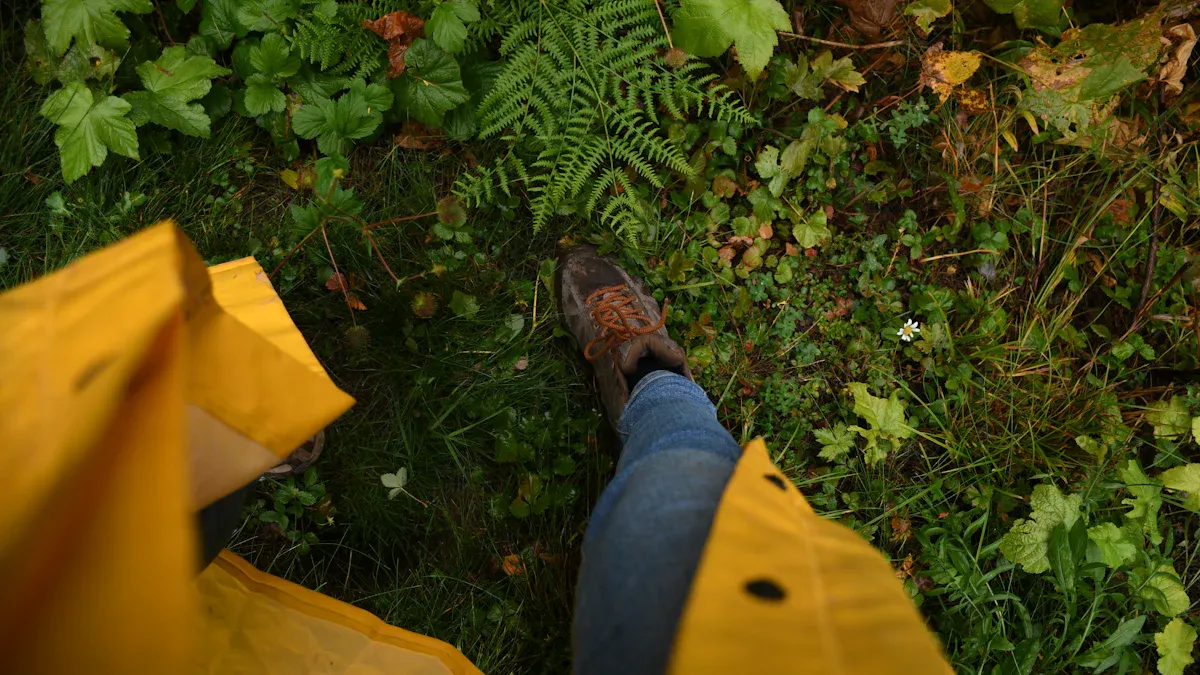
Growing blueberries in containers offers a rewarding experience for your home garden. However, blueberries are unique plants. They demand a specific soil environment to thrive. You must provide high acidity, which means a low pH, and excellent drainage. This prevents common root problems. The global demand for blueberries is high. Production reached 1.78 million tonnes in 2023. It will exceed 2 million tonnes in 2024.
Year | Production (million tonnes) |
|---|---|
2023 | 1.78 |
2024 | >2.0 |
This guide will show you how to create the perfect homemade potting soil. This ensures you grow healthy blueberry plants.
Key Takeaways
Blueberries need acidic soil with good drainage to grow well.
Mix peat moss, pine bark fines, and perlite for the best potting soil.
Check your soil’s pH often and adjust it to keep it acidic.
Use special fertilizers and mulch to help your blueberry plants thrive.
Blueberry Soil Needs

Acidity for Blueberries
Blueberries are unique plants. They are acid-loving plants. You cannot grow them in neutral or alkaline soils. The optimal pH for blueberry growth is between 4.5 and 5.0. It can go up to 5.2 if your soil is clay. For highbush blueberries, aim for a pH of 4.5 to 5.5. Rabbiteye blueberries prefer a pH of 4.2 to 5.0. Maintaining a soil pH between 4.5 and 5.5 is crucial for optimal nutrient uptake. This acidic environment helps your blueberries absorb necessary nutrients. If the soil’s pH is too high, minerals form insoluble compounds. This reduces mineral absorption. You will see micronutrient deficiencies, especially iron. This leads to plant failure for your blueberries.
Drainage Requirements
You need well-draining soil for growing blueberries. This prevents root rot. However, the soil must also retain enough moisture. Waterlogged soil is very harmful. It creates an environment for Phytophthora cinnamomi. This pathogen causes Phytophthora root rot. It produces swimming spores that infect and kill fine roots. Poorly drained, heavy soils make this disease worse. You will see brownish-black rot on fine feeder roots. This can spread to larger roots. Your blueberries will show stunted growth. Leaves become undersized and yellow. They may also turn red prematurely or scorch. Young blueberry plants are very vulnerable. They often wilt and die in severe cases. Good drainage is key for healthy roots.
Essential Nutrients
Your blueberries need specific nutrients. Macronutrients are required in large amounts. Nitrogen (N) is vital for leaf growth and chlorophyll. Phosphorus (P) helps with root growth and energy transfer. It also promotes flowering and fruiting. Potassium (K) is important for photosynthesis and water regulation. It improves fruit size and quality. Micronutrients are needed in small amounts. These include Iron (Fe), Manganese (Mn), Zinc (Zn), Copper (Cu), and Boron (B). High soil pH can cause deficiencies in iron and manganese. Boron and copper can be harmful if you apply too much. These nutrients ensure your blueberries grow strong and produce fruit. Understanding these blueberry soil requirements is essential for successful growing blueberries.
Potting Mix Ingredients

Creating the perfect environment for your blueberries starts with the right ingredients. Each component plays a vital role. You need to achieve the ideal acidity, drainage, and nutrient balance for your blueberry plants.
Peat Moss
Peat moss is a cornerstone for blueberry potting soil. It is naturally acidic, with a pH typically ranging from 3.0 to 4.5. This makes it an “Acidity King” for your soil mix. Peat moss helps maintain the low pH that blueberries need. It is also a “Moisture Magnet.” Peat moss can hold a lot of water, often 60% to 68% of its volume. Some types hold about 10 times their dry weight in moisture. This ensures your blueberries get a steady water supply without becoming waterlogged. It also adds organic matter to your potting soil.
💡 Environmental Note: Peat moss is harvested from peatlands. These are important ecosystems. They store a lot of carbon. Harvesting peat releases carbon dioxide. This contributes to climate change. Peat is also a non-renewable resource. Some gardeners choose alternatives like coco coir.
Pine Bark Fines
Pine bark fines are essential for excellent drainage and aeration in your blueberry soil. They create many “Air Pockets Galore.” This allows oxygen to reach the roots of your blueberries. Pine bark fines are a “Drainage Champion.” They ensure water moves through the soil quickly. This prevents waterlogged conditions. This makes them “Root Rot’s Worst Enemy.” Pine bark has a high lignin content. This means it breaks down slowly. It helps your soil mix keep its structure over time. This prevents compaction. For best results, use milled pine bark. Look for particles where 70% to 80% are between 1/42 to 3/8 inch in diameter.
Perlite or Pumice
Perlite and pumice are lightweight minerals. You add them to your potting soil to improve its structure. They “Boost Air Circulation” by creating pathways for air. This gives roots the oxygen they need. They also “Prevent Soil Compaction.” These materials act as permanent aerators. They keep your soil mix light. They also “Improve Drainage Further.” This allows water to pass freely.
Feature | Perlite | Pumice |
|---|---|---|
Weight | Lighter | Heavier |
Water Retention | Retains more water | Retains water, but also drains well |
Use Case | Good for drier soils, food crops | Good for desert plants, soggy soils, adds stability |
Both perlite and pumice help prevent root rot. They increase oxygen for your blueberry plants.
Organic Compost
Organic compost is a valuable addition to your soil mix. It acts as “Nutrient-Rich Fuel.” Compost provides a slow release of essential nutrients. These include both macro and micronutrients. It also offers “Enhanced Soil Structure.” Compost improves aeration and helps the soil hold water. It introduces beneficial microorganisms. These microbes help cycle nutrients. They also support overall plant health. Many composts naturally support the acidic pH goals for blueberries.
Elemental Sulfur
Elemental sulfur is your “pH Perfector.” You use it for long-term pH adjustment. When you add elemental sulfur to the soil, soil bacteria get to work. They convert the elemental sulfur into sulfuric acid. This process gradually lowers the soil pH. It creates a stable, acidic environment. This helps adjust the pH to the desired range of 4.5 to 5.5 for your blueberries. Remember, this process takes time. It relies on soil bacteria. In soilless media, it can take several weeks or even months to see the full effect.
Mixing Your Potting Soil
Creating your own potting soil for blueberries is a hands-on process. You will find it rewarding. Follow these steps to ensure your blueberry plants get the best start.
Gathering Materials
Before you begin, gather all your ingredients and tools. This makes the mixing process smooth. You will need:
Peat Moss: Your primary acidic component.
Pine Bark Fines: For drainage and aeration.
Perlite or Pumice: To further improve drainage and prevent compaction.
Organic Compost: For slow-release nutrients.
Elemental Sulfur: If you need to adjust the pH over time.
Large Mixing Container: A wheelbarrow, a large plastic tub, or a sturdy tarp works well.
Shovel or Trowel: For mixing.
Gloves: To protect your hands.
Measuring Tools: Buckets or scoops to get your ratios right.
Recommended Ratios
Many recipes exist for excellent blueberry potting soil. You can choose the one that best fits your available materials. Here are some common and effective mixes:
Simple 50/50 Mix: Combine one part sphagnum peat moss with one part shredded pine bark. This is a very popular choice for blueberries. You can also use 50% peat moss and 50% mini pine bark mulch. Some gardeners use 50% peat and 50% pine fines. You might even go slightly heavier on the peat moss.
Alternative Bark Mixes: Try 50% peat with 50% pine bark mini-nuggets. Or, use 50% peat and 50% rice hulls. These options provide good drainage.
Compost-Enriched Mix: Use 40% mini pine bark, 40% sphagnum peat moss, and 20% organic compost. This mix adds more nutrients.
Three-Part Mix: Combine equal parts peat moss, pine bark, and compost. This gives a balanced blend.
Specialty Mix: Use 1/3 1/4″ pathway bark, 1/3 peat moss, and 1/3 forest-byproduct-based potting soil, like an azalea mix.
For Poor Soil or Containers: A 50:50 mix of sphagnum peat moss and shredded pine bark mulch works well for potted culture. If you are refilling planting holes, a 1:1:1 ratio of peat moss, pine mulch, and native soil (if it is not heavy clay) is suitable.
Combining Ingredients
Now, it is time to mix your chosen ingredients. Thorough mixing ensures every part of your blueberry plants’ roots gets the right environment.
Start with the Base: Begin by adding your largest volume ingredients to your mixing container. For example, add two gallons of peat moss to a bushel basket.
Add Aerators: Incorporate two gallons of either perlite or pumice. Mix these thoroughly with the peat moss.
Introduce Bark and Compost: Add your pine bark fines and organic compost according to your chosen ratio.
Mix Thoroughly: Use your shovel or trowel to mix everything together. You want an even distribution of all components. For large batches, a cement stirrer can ensure even distribution of ingredients.
Break Up Clumps: After combining all ingredients, you can sift the media through a 1/2-inch wire mesh screen (hardware cloth). This breaks up any clumps. For a finer texture, use a 1/4-inch hardware cloth.
Prevent Compaction: Mix biologically active compost into the soil when you replant containers. This provides organic matter. It also feeds beneficial microbes. Thorough mixing prevents compaction. It ensures good air and water flow.
Initial pH Check
After mixing your potting soil, check its pH. This confirms you have created the ideal acidic environment for your blueberries.
Slurry Soil pH Test: This is a very accurate method for home use. Mix soil samples with distilled water (1-1.5ml per gram of soil). Let it sit for an hour. Stir it, then use a standard pH meter to read the value. You need distilled water, soil samples, a pH meter, containers, and a kitchen scale.
Direct Soil pH Test: This method is simpler but less accurate. Poke holes in the soil. Add distilled water to dampen the soil. Then, insert a pH meter directly into the soil. You need a ruler, distilled water, and a pH meter.
Simple pH Soil Test (Vinegar and Baking Soda): This is the least accurate method. It gives a general idea. Take soil samples. Add white vinegar to one sample. Fizzing means alkaline soil. Add water then baking soda to another sample. Fizzing means acidic soil. No fizzing suggests neutral soil.
Professional Lab Test: For consistently reliable results, submit samples to a soil-testing laboratory. A soil test from a lab is the most reliable method.
If your initial pH is not in the 4.5-5.5 range, you can adjust it. Add more peat moss to lower the pH. You can also add a small amount of elemental sulfur for a gradual, long-term adjustment.
Soil Maintenance for Blueberries
You must provide ongoing care to keep your potting soil optimal for healthy blueberries. This ensures your plants thrive and produce fruit.
Adjusting Soil pH
Regularly monitor your soil’s pH. This helps you maintain the ideal acidic environment for your blueberries. You can lower soil pH over time using various acidifying amendments.
Elemental Sulfur: Apply elemental sulfur to gradually reduce pH. Soil bacteria convert it into sulfuric acid. This process takes time, so plan ahead.
Acidifying Fertilizers: Use fertilizers like ammonium sulfate. These are labeled as acidifying and help lower soil pH with consistent use.
Organic Matter: Incorporate peat or sphagnum peat moss. Their acidic nature helps reduce soil pH.
Aluminum Sulfate: This amendment acts faster than elemental sulfur due to its high solubility.
Fertilizing Blueberries
Blueberries need specific nutrients. Use fertilizers designed for acid-loving plants.
Choose fertilizers that supply nitrogen in the ammonium form. Blueberries are sensitive to nitrate.
Look for NPK ratios like 7-7-7 or 4-3-4. Fertilizers for rhododendrons and azaleas also work well.
Consider organic options. Cottonseed meal, coffee grounds, blood meal, and feather meal provide nutrients and support acidic soil conditions. Slow-release nitrogen sources are best to prevent nutrient loss.
Mulching Techniques
Mulching the surface of your blueberry containers offers many benefits.
Mulch moderates soil temperature. It keeps the soil cool in summer and insulates roots in winter.
It increases available moisture and helps with blueberry watering. This reduces the need for frequent watering.
Mulch suppresses weeds. It also enriches the soil with organic matter as it decomposes.
Some mulches, like pine needles, can help lower soil pH, which benefits your blueberries.
Repotting Blueberry Plants
You need to repot your blueberry plants when they outgrow their current container. Stunted growth and poor fruiting often indicate the plant needs a larger pot. This condition usually happens because of compacted roots. Moving the plant to a more spacious pot gives the roots room to grow. It also allows for better soil aeration and blueberry watering.
Making your own soil for blueberries is simple and rewarding. You create the perfect soil environment. Remember the core principles for your blueberries: high acidity, excellent drainage, and proper nutrient management. These are vital for healthy blueberries. Observe your plants closely. Adjust their soil care as needed. Soon, you will enjoy a bountiful harvest from your healthy, happy blueberry bushes. This custom soil makes all the difference for your blueberries.
FAQ
Can I use regular garden soil for my blueberries?
No, you cannot. Regular garden soil often has a neutral or alkaline pH. Blueberries need acidic soil. Garden soil also usually lacks the excellent drainage blueberries require. Your plants will not thrive in unsuitable soil.
How often should I check the pH of my blueberry soil?
Check your soil pH every few months, especially after adding amendments. Regular checks help you maintain the ideal acidic environment. This ensures your blueberry plants absorb nutrients effectively from the soil.
What signs show my blueberry soil pH is too high?
You will see yellowing leaves, especially between the veins. This is chlorosis. Leaves may also turn reddish. Your plant’s growth will slow down. These are signs your soil is not acidic enough for your blueberries.
Can I reuse potting soil from old blueberry plants?
It is best not to reuse old blueberry potting soil. The soil structure breaks down over time. Nutrients deplete. The pH may also become unstable. Start with fresh soil for new plants to ensure success.
What are some good organic amendments for blueberry soil?
You can use several organic options:
Coffee grounds ☕
Pine needles
Composted oak leaves These help maintain acidity and add organic matter to your soil.

